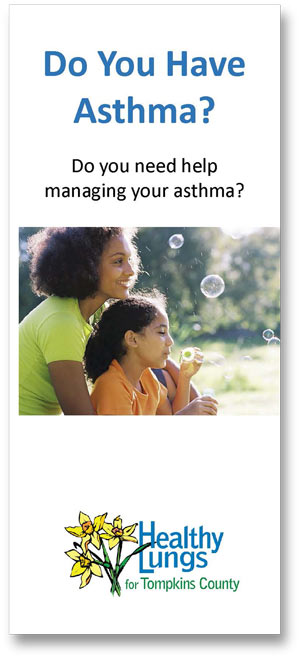Source: NYSDOH
What is Asthma?
 Asthma is a lung disease that can be life threatening.
Asthma is a lung disease that can be life threatening.
Asthma is a chronic, or long-term disease, which can affect you for the rest of your life.
Asthma causes breathing problems. The airways in the lungs get blocked, causing the lungs to get less air than normal. Symptoms of an "asthma attack" can be difficulty with breathing, a tight feeling in the chest, coughing and wheezing. Asthma can develop quickly and it can range from being a mild discomfort to a life-threatening attack if breathing stops completely. Asthma problems are often separated by symptom-free periods.
There is no cure for asthma but it can be prevented and controlled with proper care.
People with asthma can live a normal and active life.
Who Gets Asthma?
Asthma affects Americans of all ages, races, and ethnic groups but low-income and minority populations experience higher rates of hospital admissions and emergency room visits due to asthma.
Asthma is a serious and growing health problem. In 2013, approximately 21.6 million (9.0%) adults and 4.6 million (9.2%) children indicated they currently had asthma. About one in ten preschool children is diagnosed with asthma.
Could You or Your Child Have Asthma?
 A chronic cough may be the only symptom. Wheezing does not have to be present. Here are some questions your doctor may ask:
A chronic cough may be the only symptom. Wheezing does not have to be present. Here are some questions your doctor may ask:
- Do colds go right to the chest and last longer than with others in the family?
- Is there a cough and /or sometimes a wheeze, chest tightness or trouble breathing?
- Does the coughing or wheezing affect sleep?
- Is there a family history of asthma or allergies?
- How often is medication needed for any of the symptoms suggested in #2?
- During the past 2 years, was treatment in the emergency room or hospital necessary for anything in #2?
- How is work or school missed for anything in #2?
What is the Impact of Asthma?
Individuals and families feel the burden of this chronic disease everyday.
New York residents had an average of 42,725 asthma hospitalizations per year during 1998-2000. Children aged 0-17 averaged 16,539 hospitalizations per year. Asthma hospitalization rates are higher in the poor inner city populations. Hospitalization rates for children ages 0-4 are improving. In children 0-4 years of age, hospitalization rates dropped from 75.5/10,000 (1996-1998) to 72.1 (1998-2000). In children 5-14 years of age, hospitalization rates dropped from 29.0/10,000 (1996-1998) to 25.5/10,000 (1998-2000).
In New York, Asthma caused an average of 358 deaths per year in from 1998-2000. There were 12 deaths in children 0-14 years of age.
Nationally, asthma results in nine million visits to health care providers per year, over 1.8 million emergency room visits per year, and almost a half a million hospital stays per year. The estimated cost of asthma in 2000 was $14.3 billion per year. In New York, total Medicaid health care expenditures for recipients with asthma in New York State exceeded $1 billion in fiscal year 2000, inclusive of asthma related and unrelated medical services.
Asthma takes its toll in many ways. Asthma is the leading cause of school absenteeism. Asthma results in many lost nights of sleep and disruption of activities for the individual, as well as his or her family. Parents frequently miss days from work as a result of their child's asthma.
What Causes Asthma Symptoms?
Asthma causes airways, the passages that bring air to your lungs, to become very sensitive and reactive. When airways come in contact with "triggers", the airways narrow, swell and produce mucus. In addition, the muscles on the outside of the airways constrict and tighten around the airways. As a result, breathing becomes difficult. These effects cause episodes of breathlessness, wheezing, coughing, and chest tightness. Having one or several of these symptoms is called an asthma episode, or attack. These symptoms are usually temporary, and can be mild or life threatening.
What are Asthma Triggers?
Upper respiratory viral infections, house dust mites, cockroach debris, animal dander, mold, pollen, cold air, exercise, stress, tobacco smoke and indoor and outdoor air pollutants can trigger symptoms.
Asthma triggers affect people differently but studies have shown that if they are reduced or eliminated, symptoms and the need for medications are reduced and lung function is improved.
Common Factors or Triggers
- Tobacco Smoke
- Exercise
- Stress
- Cold Air
- Pollen
- Mold
- Animal Dander
- Dust Mites Debris
- Cockroaches Debris
- Diesel Exhaust
- Air Pollution
- Isocyanates
- Dyes
- Formaldehyde
- Wood Dust
Asthma Triggers at Home and in the Workplace
- Have Asthma? Take A Look Around You (English, Spanish)
- Asthma Trigger Tracker and Key Questions (English, Spanish)
- Is Your Asthma Work-Related? Work-related asthma is more common than you think. Find out if your job could be affecting your asthma, and what you can do to control your asthma at work.
How can asthma attacks be reduced or prevented?
Using the correct medications, reducing exposure to triggers and learning how to manage asthma as a chronic disease can reduce both the frequency and severity of asthma symptoms.
How is Asthma Treated?
Asthma can be treated and controlled without major limitations to your life. Each case of asthma is different but knowing the facts about asthma and how it affects you will help you work with your provider to develop a plan tailored to your needs. Talk to your doctor about your Asthma Action Plan.
What Do You Need to Do?
- Select a primary care physician/provider.
- Keep appointments even if you are not having any symptoms.
- Develop an Asthma Action Plan with your provider. Keep a copy of your plan handy to refer to. If your child has asthma, share a copy of his or her plan with your child's daycare or school.
- Learn about asthma medications.
- Learn how and when to use the right medicine.
- Take the medicine prescribed by your physician to prevent asthma symptoms, even if you are not experiencing symptoms.
- Learn what "triggers" your asthma symptoms.
- Remove and reduce the triggers in your environment that make your asthma worse.
- Learn to use a peak flow meter to see if your asthma is getting worse.
- Learn when to call for medical care and what to do in an emergency.
What Medications are Used for Asthma?
Asthma medications are an important part of your asthma treatment and prevention. Physicians and other health care providers prescribe several kinds of medications for asthma. Not all medications work the same way even if they come in the same kind of container.
There are Two Types of Medications
Long Term Control/Preventive Medications. These long-term control medicines help to lessen the frequency and severity of asthma episodes over time. They do not provide immediate relief.
Quick-Relief/Rescue Medications. These quick relief medicines are used to control the immediate relief of asthma symptoms.
These medications may be in pill or syrup form or inhaled. Pills or syrup are taken by mouth. Inhaled medication can be administered either by an inhaler or "pump" or through a nebulizer machine.
If You are Taking Asthma Medications, You Need to Know:
- The kind of medication you are taking.
- How you are supposed to take your medication.
- How the medication helps your asthma.
- The side effects of the medication.
Source: Some of this information was adapted from National Heart, Lung and Blood Institute (NHLBI), Action Against Asthma: A Strategic Plan for the Development of Health and Human Services and NHLBI: National Asthma Education Prevention Program

